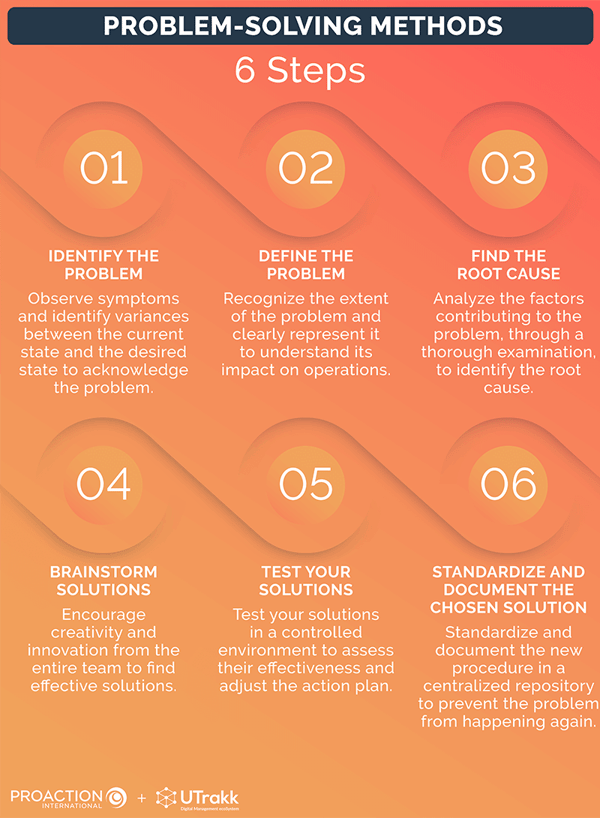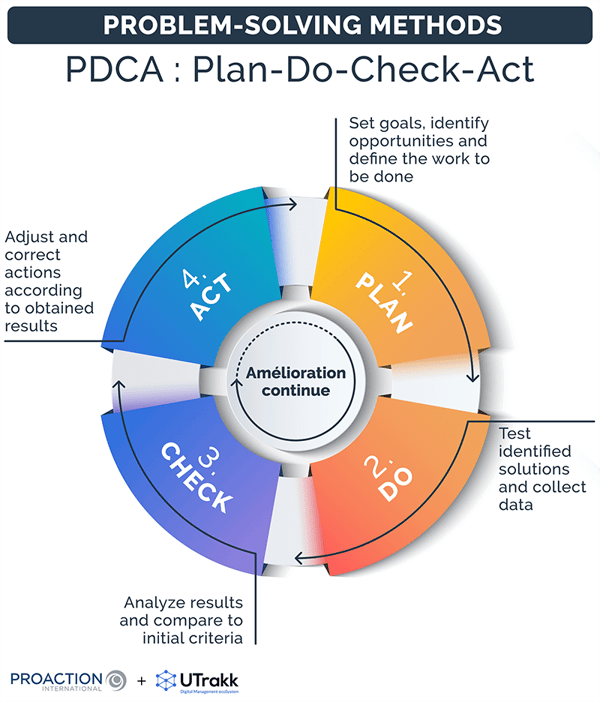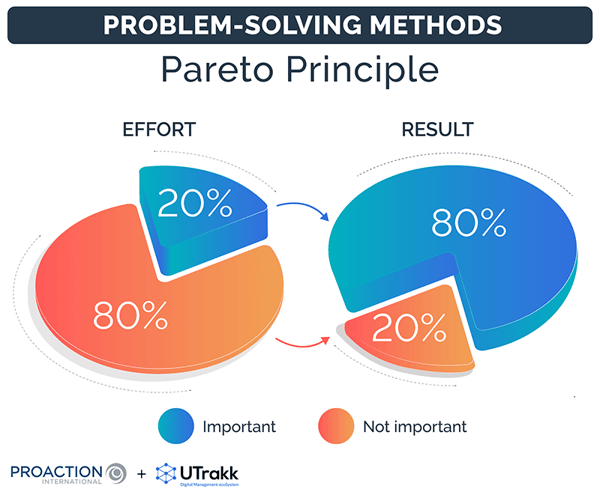Key steps of a problem-solving process in a factory
To better understand each of these steps, let's take the example of a factory manufacturing automotive components, faced with a sudden rise in the number of defective parts.

1. Identify the problem
The first step is to recognize that a problem exists. This involves observing the symptoms and identifying the gaps between the current state and the desired goal.
The 5 Ws and H tool enables you to identify the problem by collecting factual information on incidents.
Example
- Observation: Abnormal increase in the number of defective parts at the quality inspection station.
- Action: Collect data on the number of defective parts, the types of defects, and the times when they occur.
2. Define the problem
After identification, you need to precisely define the problem. This involves determining its scope (using the Four A’s method, for example), representing it clearly, and understanding its impact on operations.
Example
- Analysis: 10% of parts produced have surface defects (higher than the acceptable standard of 2%).
- Action: Clearly define the problem as a significant increase in surface defects on automotive parts.
3. Find the root cause of the problem
This step aims to analyze the factors contributing to the problem in order to identify its root cause. This is a critical process requiring in-depth examination to avoid treating symptoms alone.
Example
- Investigation: After using the 5 Whys method, the root cause turns out to be premature machine wear.
- Action: Examine maintenance records and machine operating parameters to confirm this cause.
4. Brainstorm solutions
Once the root cause has been identified, it's time to focus on finding solutions. This phase encourages creative problem-solving and innovation from the whole team. They have to explore existing ideas and generate new ones.
Example
- Brainstorming: Several potential solutions are considered, such as replacing tools more frequently or modifying machine parameters.
- Action: Evaluate the advantages, disadvantages, and feasibility of each solution using the PDCA method.
5. Test your solutions
Before implementing a solution on a large scale, it is essential to test it in a controlled environment. This enables you to assess its effectiveness in real-life situations and adjust the action plan.
Example
- Experimentation: Replace tools more frequently to see if this reduces the defect rate.
- Action: Implement the test plan over a set period using the "Do" phase of PDCA, then collect data on the impact of this change.
6. Standardize and document the chosen solution
Once you’ve found the best solution, it must be standardized and integrated into the organization's procedures. Documenting the process helps prevent the problem from recurring and facilitates employee training.
Example
- Implementation: After confirmation that more frequent tool replacement reduces defects, this practice is standardized across the entire production line using the DMAIC method.
- Action: Document the new process using the 8Ds, train operators in the new practice, and integrate the change into standard operating procedures.
5 Useful problem-solving strategies for manufacturing
1. 8D (Eight Disciplines Problem Solving)
8D is a quality approach to solving complex problems requiring in-depth analysis and lasting corrective action.
The method comprises eight steps:
- Prepare the 8D process
- Describe the problem
- Identify and implement immediate actions
- Identify the real causes
- Identify and implement permanent corrective actions
- Validate permanent corrective actions
- Prevent recurrence
- Congratulate the team
Use case in the manufacturing industry
Problem: Recurrent failure of a major piece of equipment, leading to costly production stoppages.
8D would enable a multi-disciplinary team to systematically identify, analyze, and eliminate the root cause of the failure while implementing sustainable corrective actions.
2. PDCA (Plan-Do-Check-Act)
Also known as the Deming wheel, this systematic, iterative model comprises four stages or cycles: Plan, Do, Check, Act.
The PDCA method helps companies test changes under controlled conditions, evaluate the results, and then implement improvements progressively to optimize production and ensure consistent product quality.
Use case in the manufacturing industry
Problem: Variation in the quality of the finished product, which does not always meet standards.
PDCA would address this problem by planning improvements, testing them, evaluating their effectiveness, and adjusting the production process to stabilize product quality.

3. DMAIC (Define, Measure, Analyze, Improve, Control)
This Six Sigma method is highly effective in optimizing production processes, reducing variation, and eliminating defects by focusing on data and statistical analysis.
It involves clearly defining the problem (Define), measuring (Measure), and analyzing process data to identify root causes (Analyze), then implementing improvements (Improve) and controlling processes to ensure sustainable quality gains (Control).
Use case in the manufacturing industry
Problem: High scrap and rework rates on an assembly line.
DMAIC would be used to specify the problem, measure performance, analyze data to find the cause, implement improvements, and control the process to reduce defects.
4. QRQC (Quick Response Quality Control)
This fast, effective method inspired by Lean Management, consists in identifying, analyzing and solving problems directly on the shop floor. It is particularly well suited to fast-paced production environments where immediate detection and resolution are necessary to maintain production continuity and efficiency.
Use case in the manufacturing industry
Problem: Frequent safety incidents in the workplace.
QRQC would enable rapid reaction to identify and resolve the causes of such incidents immediately, thereby reducing their frequency and improving overall safety.
5. Four A’s
The Four A’s method is a structured approach that is designed to systematically address and solve problems within an organization.
- Assess: This step involves identifying and understanding the problem.
- Analyze: Once the problem is assessed, the next step is to analyze it to find the root causes.
- Address: With a clear understanding of the root causes, the third “A” involves developing and implementing solutions to address these causes.
- Act: The final “A” focuses on standardizing the correct solution and integrating it into the organization’s processes.
It is used where problems need to be solved quickly and efficiently while ensuring that lessons learned are integrated into standard practices.
Use case in the manufacturing industry
Problem: Missed delivery deadlines due to production bottlenecks.
The Four A’s method would help to quickly detect bottlenecks, analyze their causes, find and implement effective solutions, and then integrate these changes into regular operations to improve on-time delivery.
How to choose the right problem-solving method
The choice of problem-solving method depends on several factors:
- The nature and complexity of the problem: Before choosing a problem-solving approach, you need to understand exactly what is wrong. If it's a complex and multifactorial problem, structured, in-depth methods such as 8D or DMAIC may be appropriate. For more immediate or quality-related problems, QRQC or Four A’s may be more appropriate.
- Company objectives: Look at the big picture; align the method with your strategic objectives, such as improving quality, reducing costs, or increasing customer satisfaction. For example, DMAIC is often chosen for defect reduction and process optimization objectives.
- Available resources: Think about the resources you can allocate to problem-solving processes (time, skills, budget). For example, PDCA can be implemented more quickly when resources are limited.
- Team expertise and problem-solving skills: Use a method that matches your team's qualifications. Training may be required for more complex approaches such as DMAIC or 8D.
- The need for standardization and documentation: If documentation and standardization of processes are essential, opt for methods that integrate these aspects, such as 8D or DMAIC.
5 Tools for structuring your problem-solving methods
Now it's time for the problem-solving tools! These will help structure the process and keep it moving in the right direction.
1. The 5 Whys
This problem-solving technique, created by Toyota founder Sakichi Toyoda, involves asking the question "Why?" five times until the root cause of a given problem is revealed. It's a simple but powerful tool for finding root causes.
Use case in the manufacturing industry
A factory has a problem with late delivery of finished products:
- Why is the plant experiencing delays in the delivery of finished products? Because the production of final units is often late.
- Why is the production of final units behind schedule? Because assembly takes longer than expected.
- Why does assembly take longer than expected? Because parts needed to complete assembly are often missing.
- Why are parts often missing? Because supplies regularly arrive late from the supplier.
- Why do supplies arrive late from the supplier? Because orders are placed too late, due to an inefficient procurement process.
2. The Ishikawa diagram (5M)
Also known as the "fishbone diagram" or "5M", this tool developed by Kaoru Ishikawa helps to systematically visualize all the potential causes of a specific problem, as well as the contributing factors.
Causes are divided into 5 main categories.
Use case in the manufacturing industry
A factory encounters a problem with a drop in product quality:
- Problem or "Effect" (fish head): Decline in product quality
- Categories of causes (main branches):
- Manpower: Operator skills, training, motivation.
- Methods: Work procedures, quality standards, operating instructions.
- Materials: Raw material quality, batch variability, supplier specifications.
- Environment: Working conditions, temperature, humidity, dust.
- Equipment: Equipment wear, machine calibration, maintenance.
3. The 7M
This evolution of the Ishikawa diagram focuses on not five, but seven major problem areas: Manpower, Method, Materials, Environment, Equipment, Management, Measurement.
Use case in the manufacturing industry
A factory is experiencing machine failure problems:
- Manpower: Inadequate operator training, human error due to fatigue, or lack of experience.
- Methods: Obsolete production processes, and lack of standardized operating and maintenance procedures.
- Materials: Inconsistent quality of raw materials, premature wear of spare parts.
- Environment: Unsuitable working conditions, disturbances due to excessive noise or vibration.
- Equipment: Outdated equipment, neglected or inadequate preventive maintenance.
- Management: Inadequate decision-making, and insufficient communication between departments.
- Measurement: Uncalibrated or faulty measuring instruments, lack of regular quality controls.
4. The Pareto principe
The Pareto or 80/20 principle is very useful for focusing on the problems that will have the greatest impact once solved, and for making informed decisions.
Use case in the manufacturing industry
In a factory producing electronic components, 80% of production defects stem from just 20% of the manufacturing processes.
By analyzing production data, the company could discover that the majority of defects are linked to errors in the soldering and PCB inspection stages. These two stages, although representing a small part of the total manufacturing process, are crucial and require special attention to reduce the overall number of defects.

5. The 5 Ws and H
This tool helps gather comprehensive information on a problem by answering these key questions: Who, What, Where, When, Why, and How. Thus, it provides an in-depth understanding of the situation.
Use case in the manufacturing industry
There is a delay in production at a furniture manufacturing plant:
- Who is affected by the problem? Assembly line operators and production managers are directly affected by the delay.
- What exactly is the problem? Deliveries of finished furniture to customers are several days behind schedule.
- Where exactly is the problem occurring? The problem occurs in the final assembly shop, where the furniture is prepared for shipment.
- When was the problem detected or when does it occur? The delay has been observed over the past two weeks, mainly during the third shift.
- Why does the problem occur? The problem could be due to inadequate staff planning and recurring packaging equipment failures.
- How does the problem occur? The delay is due to a bottleneck in the finishing and packing stage, where there is a lack of personnel and problems with the packing equipment.
Other tools can also be useful for structuring problem-solving methods:
- Brainstorming
- A3
- Gemba Walks
- SWOT analysis
- Histograms
- Control charts
- Prioritization matrices
Tips for effective implementation of problem-solving techniques
Integrate problem-solving into daily routines
Instead of seeing problem-solving as a separate activity, integrate it into daily routines. For example, set up SIM meetings to discuss ongoing problems as a group and monitor progress on solutions.
Use technology for your benefit
Adopt a Daily Management System (DMS) like UTrakk to quickly identify problems, track corrective actions, facilitate collaboration between teams, and document solutions in a centralized repository.
Develop specific key performance indicators for problem resolution
Define Lean KPIs that measure the effectiveness of the problem-solving process (average time to solve the problem, problem recurrence rate, and impact of solutions on business performance).
Practice problem-solving on the shop floor
To understand problems, you need to go where value is created. Encourage managers to go on the shop floor to directly observe processes, interact with operators, and identify possible improvements.
Create cross-functional problem-solving groups
Form teams with members from different departments to tackle complex problem-solving. Integrating different angles, perspectives, and expertise broadens the point of view on the subject, enriches the analysis, and generates more creative ideas.
Adopt a coaching approach to skills development
In addition to basic training, use mentoring and coaching to develop problem-solving skills. Experienced employees can guide less experienced ones, sharing their know-how.
Conduct post-mortem reviews
When a problem is solved, conduct a post-mortem to discuss what went well, what didn't, and how processes can be improved.
Tracking and evaluating each solution implemented allows you to adjust strategies as needed, learn from past experiences, and foster continuous improvement.
UTrakk: Your ally in structuring and optimizing problem-solving
Using organized methods and analytical tools to tackle challenges is essential for manufacturers seeking to improve operational efficiency and product quality. UTrakk DMS is the perfect solution for this structured approach to daily problem-solving. With its multiple functionalities – rituals, actions, dashboards, and more – this Daily Management System can adapt to any problem-solving method to optimize every step of the process. Once a solution is standardized, it can be documented in UTrakk’s Knowledge Center to ensure compliance and prevent recurrence.
Adopting these problem-solving techniques not only enables manufacturers to respond effectively to today's challenges, but it also lays the foundations for continuous improvement, ensuring their competitiveness in an ever-changing industrial environment.










